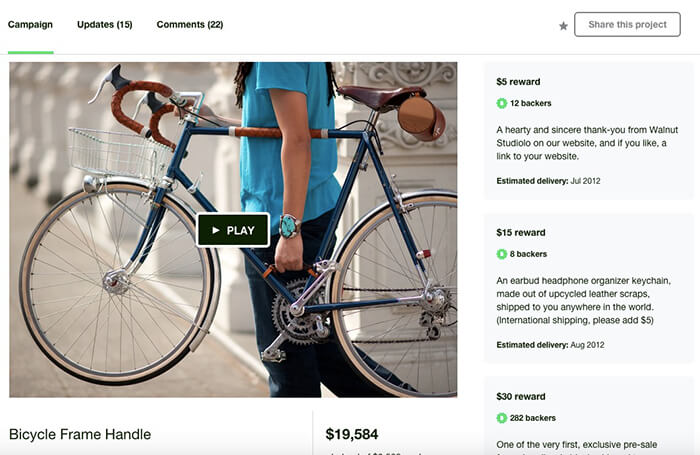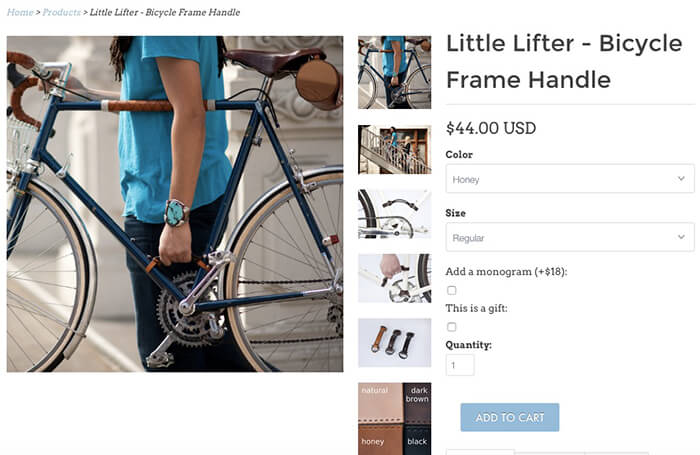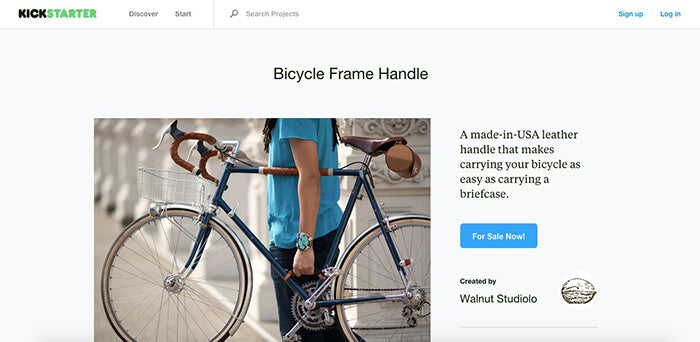In 2012, a year after quitting their day jobs to run their business, Walnut Studiolo, Valerie and her husband Geoffrey, had the idea for a new product. A bicycle frame handle made from leather, that could comfortably allow cyclists to carry their bikes.

After some brainstorming, they looked to Kickstarter to help fund and validate their product idea. Within three days, they met their fundraising goal and wound up raising over five times the amount of money they asked for. On June 16 2015, Valerie and Geoffrey launched a new Kickstarter campaign to fund their next project, which is still on-going at the time of this article being written.

I had the chance to speak with Valerie to talk about their very successful Kickstarter campaign, as well as their latest on-going campaign for The UpCycle Cage, a bicycle water bottle cage made from upcycled stainless steel water bottles.

via Kickstarter
In this interview, you’ll discover what they learned from their two Kickstarter campaigns and how to apply it to your campaign and how you can use crowdfunding sites to help create and launch your next product idea with zero capital.
Give us a little background on your product and why you chose Kickstarter as a means of helping fund the creation of your product?
We chose Kickstarter to launch our Bicycle Frame Handle in 2012 for three main reasons:
- We thought this particular product would benefit from being introduced via video first, so potential customers could see how the frame handle helps one lift a bicycle up stairs - at the time, Kickstarter seemed like the best way to do this, where the video is usually the first thing people see.
- We wanted to fundraise a small amount of money to start purchasing our leather in bulk quantities.
- We wanted to reach out to a new audience (the Kickstarter audience) and do something "newsworthy" to bring attention to our new product
Secondarily, although we thought we had an awesome product, we wanted to take the opportunity to test the market and gauge interest before doing a formal launch.
Here are the links to the Kickstarter and the corresponding product on our Shopify site:

Bicycle Frame Handle Kickstarter

Bicycle Frame Handle Shopify Product Page
Can you talk about your first experience with Kickstarter and the success you had?
Our Bicycle Frame Handle Kickstarter was a tremendous success. We reached our $3,500 fundraising goal within the first three days.
Our project was covered by many blogs and media, including CoolMaterial, Core77, and several important bicycle blogs like BikePortland.org and BikeSnobNYC.com, which assisted in our funding, but the majority of our backers (64%) found us directly through Kickstarter. In the end, we ended up raising nearly $20k, about 550% of our fundraising goal.

Free Video Series: Ecommerce Inspiration
Feeling uninspired? Watch some of the world's most successful entrepreneurs share their best advice for new business owners.
Get our Ecommerce Inspiration video series delivered right to your inbox.
Almost there: please enter your email below to gain instant access.
We'll also send you updates on new educational guides and success stories from the Shopify newsletter. We hate SPAM and promise to keep your email address safe.
What did you do to get press for your Kickstarter?
I sent out a press release to a curated email list of bicycle blogs and magazines, since both were for bicycle products. In 2012, it resulted in lots of press. In 2015, for the UpCycle Cage, I sent it to the same list, and got no response at all!

via Core77
How did you come up with the price/amount needing to be raised ahead of time?
In 2012, $3,500 was equal to a minimum wholesale purchase of leather. Basically, we simply put the amount we needed for our project. We had calculated our shipping costs into our price, and luckily we had the experience to know what shipping costs would actually be. However, we hadn't done a good job of calculating all of the fees and commissions we would need to pay. Between Kickstarter and Amazon Payments (Kickstarter now uses Stripe instead of Amazon Payments), they kept a little over 10% of the proceeds, which was more than we had bargained on. Luckily we were over-funded, which made up for it somewhat, but our margins got very very tight, very very fast, because we were offering a discounted product price for backers.
Likewise, in 2015, $3,500 is equal to what we need for a laser-engraver, minus what we've saved up for it already, and plus commissions and fees (Kickstarter now offers a + shipping pledge option).
What did you do to prepare for your first Kickstarter? Anything you did differently the second time around when preparing?
For our first Kickstarter, we agonized over every word and every detail. We spent several months writing the script for the video, filming the video, photographing the products, and photographing the other project rewards.
When writing the script for the video, I have a couple tips.
First, it was really convenient to have a video where, for the most part, much of the video was divorced from the speech - that is, video of B-roll with us speaking over it. This way we could tweak the final script as necessary using video editing rather than re-recording. We recorded a few alternatives - for example, we weren't entirely sure what our funding level would be, so we recorded ourselves saying different dollar amounts. Then our video editor was able to just plug and play with the correct dollar amount once we'd nailed it down at the last minute.
Second, most Kickstarter videos need to be kept short, preferably under 3 minutes, and they tend to follow a similar pattern: (this is who we are) + (this is our product) + (this is the problem our product solves) + (this is why our product is a great solution) + (we need your help) + (this is why we need your help) + (thank you for watching!)
The reason it took us so long is because to make a compelling video script, we really needed to have the entire Kickstarter project concept fully baked. It's only a few sentences, but each word in each sentence is so important that it took time and lots of revisions to get right. It's hard to ask for help, so articulating "why we need your help" was particularly difficult.
Photography took a while because we had to first, develop a prototype we loved, then make a version that was photo-ready, for each of the rewards, before we could even schedule a photographer. Both times, we didn't think about the lower-level rewards early enough, and it added to delays. Decide on all your rewards as soon as you can, don't wait until after you've finalized the main product.
viaYouTube
The second time around, we had a lot of material to work with already, so we were able to pull it together much faster, and we stressed about it a little less.
What were a few of the keys to the success of your most recent Kickstarter?
In hindsight, I attribute our success partly to having a great product with great photography and a good-enough video; partly to a modest funding goal and a low and discounted product price ($30 for a frame handle); and partly to good timing with Kickstarter: 2012 was a good year to be on Kickstarter, and at the time we were one of few bicycle projects.
What were some of the things you did on a daily basis while the project was up and running?
Every day during the first project, we were carefully tracking pledges and total quantities. Once the project had decisively "tipped" into funding, we began ordering materials and beginning work on rewards. We sent regular project updates, and every day we were looking at our analytics to see what sites had referred to us so we could track them and share them via social media.
In your opinion, what kind of business or products should consider Kickstarter as a means to raise money for their business?
Kickstarter has changed a LOT since 2012, but I think the elements of our successful campaign that translate to others is a product that has a near universal fit, a broad-appeal, and has an invention-like twist (an "aha!" moment) with a low price tag. In general, it seems that tech gadgets and video games do exceptionally well on Kickstarter. In 2012, it seemed like we were able to benefit by reaching Kickstarter's audience, but now Kickstarter is so flooded with projects, ideally only companies, groups, or individuals with an existing audience are more likely to get funded.
Do you have any tips or suggestions for anyone looking to fund their next product or project using Kickstarter?
For someone using Kickstarter to fund their next project, first make sure you get a feel for the platform. Spend some time looking at other Kickstarter projects you like and don't like, and if you're able to do so, back a few so you get a feel for the experience from a customer's point of view.
When you're getting your project ready, invest the time into creating a good video and good product photography - I say invest "time" not money because it doesn't need to be a slick, professional video (in fact, this can be a turn-off to some backers) - it just needs to be compelling.
Spend a lot of time getting your unique value proposition right and into one sentence or less. And mix up the reward levels somewhat, but don't offer so many rewards that the menu becomes fatiguing to read. You can always start out with a simple rewards structure in the beginning and if you get special requests or good ideas from potential backers you can add more categories while it's funding. Early Bird rewards are an effective way to start converting backers fast.

via Kickstarter
Once you've launched, be a tireless self-promoter! Spread the word regularly in your personal and professional networks, and in press release form to only relevant media contacts.
If your Kickstarter is successfully funded (hooray!), keep regular, open, and honest lines of communication with backers while you're fulfilling rewards. It's better to communicate problems promptly - nothing is worse than silence! Keep the tone of all your communications professional and in the same voice.
Also, I would consider alternate, niche crowdfunding sites, other than Kickstarter. There are many new ones springing up, and each seems to be aiming for a specific niche. If your campaign fits that niche, perhaps it will be a better fit than going on the "big dog" site. Or you could try a Shopify app that does pre-sales, which is almost like custom crowdfunding but not quite.
My Takeaways From My Interview With Walnut Studiolo and What You Should Consider
- Crowdfunding is an excellent tool for entrepreneurs that need to raise money quickly for their invention or product, however, it’s not for everyone and reaching your funding goal is anything but guaranteed. It’s not a guaranteed thing.
- Preparation is everything. Work on the copy for your crowdfunding campaign, take amazing, high-quality photos, have a great video and start to form some relationships with magazines and blogs in your niche for some coverage when you launch.
- Sites like Kickstarter can bring a new audience to your ecommerce business and product – one you might not have otherwise reached. However, don’t rely on sites like Kickstarter to drive traffic to your campaign. Your campaign is more likely to succeed if you have an established audience and brand.
- If your product has a unique twist and mass appeal, it might be a great product to try and crowdfund.
- Take the crowdfunding site’s fees into consideration when coming up with a fundraising goal. (Kickstarter takes 5% of your funding total and 3%-5% payment processing fees if your project is funded. There are zero fees if your project isn’t funded successfully)
- If crowdfunding makes sense for your business or product, consider less competitive, niche crowdfunding sites.
Kickstart Your Business
Crowdfunding sites like Kickstarter provide a unique opportunity today for entrepreneurs who have the idea but don’t have the money. However, it’s clear from Walnut Studiolo’s experience and advice that while success is certainly possible, it’s not guaranteed.
It might also be a good idea to look through these crowdfunding sites and see if a product similar to yours has already been successfully funded to give you an idea if it’s worth it for your business. Be sure to check out our Ultimate Guide to Crowdfunding before you dive in, for a detailed and comprehensive walkthrough of setting up your first fundraising campaign. If you have any questions about Kickstarter or crowdfunding, or you’d like to share your experience using crowdfunding, leave a comment below. I engage and respond with everyone.
About The Author
Corey Ferreira is a passionate entrepreneur, coconut water lover and content creator at Shopify.

